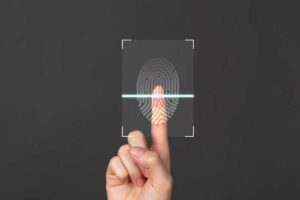Biometric ID technology allows individuals to verify their identities through the comparison of certain characteristics to a database, including fingerprints, palm scans, retinal patterns and facial images stored as biometric samples – or DNA for that matter.
Other biometrics include gait recognition, handwriting analysis and speaking behaviors analysis. All this data is converted to digital form for quick comparison and identification on devices.

What is Biometric ID?
Biometric ID refers to the practice of identifying individuals using distinguishable physical traits such as fingerprints, face recognition or voiceprint recognition. Biometric identifiers have become increasingly popular as passwords become less relevant. Not only can biometric identifiers speed up login and access processes but they may also help prevent identity theft; according to Crime Museum statistics 15 million US residents experience identity theft each year costing $50 billion dollars in financial losses alone; using biometric identification systems can ensure users are who they say they are both digitally and in physical spaces.
Biometric ID systems require sensors or scanners capable of taking high-resolution digital images of physical characteristics for comparison against an identifier stored in their database, either remotely through smartphone with integrated sensors, or physically by human examiners in person. Comparison results depend on several factors including age and health status.
Biometrics provide an effective means of identification and verification as they are difficult to replicate or hack, unlike more traditional forms such as passwords. Although not completely reliable, these systems do fail to recognize people at times due to changes in physical characteristics like cuts, dry skin or other variables; nonetheless the rate of false rejections should remain below one percent.
Biometrics are used for identification
Biometric identification relies on measuring and recognizing unique physical traits that remain constant over time, so they cannot be falsified or stolen. Different biometric technologies such as fingerprints, retinal scans, facial recognition and voice analysis may all be utilized as ways of identification.
Fingerprint recognition is one of the most widely-used biometric identification techniques, using a scanner to capture an individual’s fingerprints and create a digital template of their unique characteristics. A computer program then compares any input against this database to verify identity; whether there is a match or no match determines whether access will be granted for accounts, devices, or services.
Biometric technology is expanding quickly. With an explosion of available scanners, cameras, microphones and touch screens as well as algorithms capable of matching and recognizing human features becoming available for biometric verification by both government agencies and private companies alike. This has made biometric verification an effective solution.
Recently, fingerprint authentication on smartphones and tablets has become more prevalent. This system can be activated without needing to enter passwords or PIN numbers, helping prevent identity fraud when making transactions online. Unfortunately, though, the technology isn’t foolproof: an unscrupulous fraudster may still be able to circumvent it by altering physical features like their nose shape or distance between their eyes in an effort to bypass identity verification systems.
Biometrics are used for security
Biometrics have become a part of everyday life, from using fingerprint recognition to unlock your phone to using voice-recognition assistants and facial recognition for airline check-in. Biometrics often serves as an identity verification measure – replacing standard passwords or other forms of identity verification methods with this innovative technology.
Biometric verification systems come in various varieties, each offering their own set of advantages and drawbacks. Biometrics can be an effective tool in detecting fraud while assuring only those authorised can access services or products, yet like any form of verification it cannot provide complete protection on its own – thus often being supplemented by another factor (like pin or password authentication) to increase security.
Biometrics consist mainly of fingerprint, face, and iris scans collected using cameras or sensors, digitalized using software, compared against stored data, and stored. They are all extremely difficult for hackers to replicate or steal due to the nature of biometric technology.
While technology has become more pervasive, it does present privacy issues. People may worry about function creep, where information collected for one purpose ends up being used for another; and covert collection, where devices collect data without user knowledge or consent. Best practices exist to address these concerns such as reinforcing passwords and using different logins on every site to reduce hackers’ access to sensitive data.
Biometrics are used for authentication
Biometric authentication technologies are increasingly utilized across industries. Biometrics provide protection for users while simultaneously increasing customer experience by shortening identification and verification processes. Biometric authentication also reduces costs related to fraud, loss of credentials, and phishing attacks.
Voice recognition, face scanning, hand geometry analysis or retinal scanning: biometric sensors convert your physical characteristics into digital data that’s stored on a database. When you present yourself to the system with those characteristics in question, its software compares it with what was on file to identify matches between presented data and those already stored to detect the best fit possible matches between you and what exists in its files.
Most people are familiar with facial recognition technology found on many smartphones; this form of biometric security can also be used to unlock doors or access computers. Another form of biometric protection known as iris or retinal scanning uses infrared light to capture images of blood vessels on your eyes and the backs of eyelids – often employed at places requiring high security such as nuclear research facilities.
Although biometrics provide a strong form of verification, they can still be compromised by hackers that gain knowledge of the technology behind them. Hackers could potentially learn how to fake fingerprints or iris scans using robots which mimic these characteristics – thus biometrics should always be combined with another form of authentication such as password or PIN protection for greater protection.